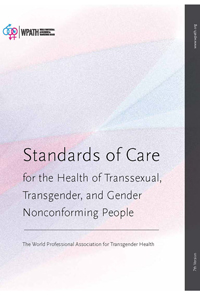A Variety of Perspectives on the Standards of Care for Transgender People
 A few weeks ago I received in the mail a hard-copy of the 7th Edition of the WPATH Standards of Care for the Health of Transsexual, Transgender, and Gender-Nonconforming People (WPATH stands for the World Professional Association for Transgender Health, of which I am a member of). Although I had fairly solid knowledge of what makes up the Standards of Care (SOC) – as is encouraged of any practitioner working with transgender clients – I figured it wouldn’t hurt to give myself a refresher course on it’s content.
A few weeks ago I received in the mail a hard-copy of the 7th Edition of the WPATH Standards of Care for the Health of Transsexual, Transgender, and Gender-Nonconforming People (WPATH stands for the World Professional Association for Transgender Health, of which I am a member of). Although I had fairly solid knowledge of what makes up the Standards of Care (SOC) – as is encouraged of any practitioner working with transgender clients – I figured it wouldn’t hurt to give myself a refresher course on it’s content.
I’ll be sharing my thoughts on the SOC at the end of this post. But for now, in the spirit of this blog being here to share the voices of the trans community, I’m going to go over a few of the differing opinions that are out there in regards to the SOC. These varied perspectives on the SOC are brought up regularly by many of my transgender clients, so I’ll do my best to cover them here.
First, a word from WPATH…
This comes from the letter which accompanied the 7th Edition of the Standards of Care, so you can see in WPATH’s words what the goals and intentions are of the SOC.
The Standards of Care (SOC) are the backbone of WPATH. Many transgendered (sic) individuals seek hormonal and/or surgical reassignment and the SOC sets forth minimum standards of care and guidelines for their medical and psychological treatment. The SOC is designed to enhance the quality of health care that transsexual, transgender, and gender-nonconforming people receive and ultimately facilitate a lasting personal comfort with their gendered self in order to maximize overall psychological well-being and self-fulfillment. While it is primarily a document for health professionals, the SOC may also be used by individuals, their families, and social institutions to understand how they can assist with promoting optimal health for members of this diverse population.
Favorable Response to the SOC
There are those who believe that the changes made in this latest edition of the SOC accurately reflect the evolution of our society becoming more understanding of what it means to be transgender. They would also note that this edition includes more holistic guidelines to transitioning that go beyond merely the psychological and medical needs of transgender individuals.
Here’s a summary of the changes, as well as a favorable statement made by the authors as to why the SOC are an essential part of transgender health and wellness.
The Top 10 Things Trans People Should Know About the New Standards of Care – from the National Center for Transgender Equality
Significant features of the new edition include:
- Recognition that gender nonconformity in and of itself is not a disorder.
- Strong affirmation that attempts to change a person’s gender identity through “reparative” therapy are ineffective and unethical.
- Strong affirmation that transition-related treatments such as hormone therapy and surgery are medically necessary for many individuals and should be covered by insurance.
- Continued emphasis on the individual nature of transition-related care and the flexibility of treatment guidelines.
- Additional guidance on the treatment of adolescents and children, including guidelines for puberty-delaying treatment.
- Near elimination of the “real-life experience” requirement as a prerequisite criteria for medical transition in adults, with the exception of some genital surgeries.
- Discussion of a wider range of treatment options, including voice and communication therapy.
- Discussion of the preventive care needs of transgender people.
- Clarification that the Standards of Care should be applied in their entirety to those who are incarcerated or otherwise living in an institutionalized setting.
- A call for health professionals to advocate not only for their patients – for example by helping them obtain updated identity documents – but also for larger policy and legal reform promoting tolerance and equality.
The revised Standards of Care represent a step forward in ensuring that all transgender and gender nonconforming people have access to high-quality, respectful care responsive to their individual needs.
Not-So Favorable Response to the SOC
Next, there is the response from some who believe the SOC enable practitioners to act as gate-keepers to those who wish to move forward with transitioning. In past versions of the SOC this was especially noticeable in regards to the “12-months of real-life experience” patients were required to have before being able to begin Hormone Replacement Therapy.
Although many of these conditions were lifted, as well an emphasis placed on these being “guidelines” and not “requirements,” there is still suspicion on the part of some folks that transgender population’s best interests are not being kept in mind during the creation of the SOC.
An example of this perspective follows:
American Psychiatric Association Dumps WPATH Standards of Care – from GenderTrender
WPATH guidelines for psychiatric/medical/surgical “treatment” of “gender” have never been based on any research or study into the treatments they advocate. Instead, the guidelines were created by those interested in making a living off the burgeoning gender treatment market. As the practice of genderiam explodes in popularity (some clinics showing a doubling of business ANNUALLY) tension between the APA and WPATH has grown…As expected, the updated WPATH standards of care guide offered no pretense of objectivity or professionalism and reads as more of a genderist political manifesto. Citations attached were cherry-picked to support the WPATH political platform, many attached haphazardly. Indeed, WPATH 7 even uses previous (scientifically unsupported) versions of it’s own guidelines as a citation supporting the new ones! Kind of a big no-no…
A Middle-of-the-Road Response to the SOC
Lastly, there are those who agree with how the SOC is able to provide a certain amount of structure to the transition process that can be quite valuable to the client/patient in the long run. At the same time the “medical-izing” of transgender care is still something that makes a lot of people uncomfortable, even if it is a necessary means-to-an-end to help alleviate Gender Dysphoria. Here’s something I came across that demonstrated this point of view nicely:
It’s Important to Know “The Rules” – from Transsexual Road Map
Some (myself included) consider it a “ritual document” with little clinical usefulness. I believe its primary purposes are first and foremost to protect health care service providers and to legitimize our access to health care service by medicalizing gender variance…I basically followed the Standards of Care very closely, and I’m glad I did. I think it forces you to stop and consider what you really want and what is going to make you happy. It’s a very conservative approach to dealing with transsexualism, and I personally feel that a cautious route carefully planned and implemented has a greater chance of leading to happiness…The Standards of Care are also a bit too cookie-cutter in their approach to the wide spectrum of women who present themselves for gender therapy. I think it’s highly situational. The SoC also seem lacking in their ability to distinguish between stable, socially adjusted women and those who are in need of serious counseling.
One Gender Therapist’s Response to the SOC
From my perspective as a gender therapist I would say reading through the 120-page SOC document helped me in several ways.
Because my area of expertise is the counseling aspect and not the medical, I appreciated the detailed information provided regarding the effects of HRT on patients, as well as descriptions of the various surgeries that persons who are transgender may wish to undergo.
I also found the section on treating children and adolescents with Gender Dysphoria to be highly insightful. Even though I don’t work with this age group I am pleased I am now more aware of the process they embark upon. I am oftentimes asked by both friendly and not-so friendly folks, “How does a kid know they are transgender? When do they get to start hormones, or have surgery?” My knowledge base has increased on this subject area thanks to what I studied in the SOC.
There’s also information about reproductive health and lifelong preventative care that, again, is more on the medical side of things but are issues that I feel I need to be aware of as a gender therapist so I can discuss them with my clients.
There were a few statements here and there in the SOC that I put question marks next to, mainly if I disagreed with the way something was phrased. I also cringed from time to time at what could be perceived as a certain rigidity to the notion of gender. However, I also understand that this document was created for a certain purpose and, considering how professional it needs to be in it’s presentation, it did a fairly good job with acknowledging the many different paths people can take during transition. It was repeated several times that the question that needs to be asked of the health professionals is, “How is this helping the patient moves towards their gender goals?”
I can also understand why even the existence of the SOC is difficult for a lot of people who are transgender. Having Gender Dysphoria and doing something about it is a lengthy, costly, risky, exhausting road to have to take. When someone transitions they want to be able to trust that their therapists and physicians and surgeons are not taking advantage of them financially, and that they are providing the care they deserve.
Remember, for many folks transitioning is not a matter of “should I do this or not” – to have to live as the gender they are assigned and not the one they truly feel to be is even more of a nightmare than going through the process of transitioning.
Homework Assignment
As I mentioned, the SOC is 120-pages long. However, if you are a practitioner (be it counselor or physician) who wishes to work with transgender clients, please download and read this document. If you are transgender and are planning on transitioning, please do so as well. The more you are aware of what the Standards of Care involve, the more prepared you can be when it comes to what to expect down the road. It also gives you a chance to come prepared with questions for your practitioners, and to show them that you are going to act as your own advocate during this process.
Click here to download the 7th Edition of the WPATH Standards of Care
Also, for everyone reading this, keep in mind that your education shouldn’t come just from the SOC. Take in information from as many trusted sources as you can. Even the writers of the SOC admit that there is still a lot of research that needs to be done, when it comes to transgender care, and innovations and changes will continue to occur. My hope is that it will only continue to improve. In the meantime, we can all help the process by sharing our experiences – both those who are practitioners and those who are transitioning.





Zoe Ellen Brain
August 3, 2013 at 11:25 AM“However, if you are a practitioner (be it counselor or physician) who wishes to work with transgender clients, please download and read this document.”
It should be mandatory reading, otherwise you’re hopelessly incompetent.
That’s not to say that it’s 100% correct: but to even consider treatment without having thorough familiarity with it would be like being an MD who’s never heard of Grey’s Anatomy, nor the germ theory of disease.
It’s by no means sufficient for competence; it is however necessary. I’d recommend reading both the previous version, the DSM-IV-TR section on Gender Identity Disorder, the DSM-5 section on Gender Dysphoria, the Praeger Handbook on Transsexuality, and various essays available online by Anne Vitale too.
For mental health professionals, Prof Syd Ecker’s presentation to the APA 2009 annual conference on the subject as well. For endocrinologists, there’s rather more.
Please remember that Transgender is an umbrella term, covering people with mild gender incongruence not requiring treatment, to those in whom it’s something of a medical emergency. This can get particularly fraught when there’s a degree of biological Intersex too, sometimes the trajectory is identical to the most severe cases of “classic transsexuality:, but sometimes completely different from Transgender in general.
darahoffmanfox
August 3, 2013 at 8:46 PMI’m always appreciative of the additional information you’re able to provide Zoe, thank you much. I tried to download Prof. Ecker’s presentation from your blog but it gave me an error message. Do you know of another way I can acquire it?
Readers, here is the link for the Praeger Handbook on Transsexuality:
http://www.amazon.com/The-Praeger-Handbook-Transsexuality-Psychology/dp/0275991768
This is the website for Ann Vitale: http://www.avitale.com/. I’ve had several clients introduce me to her work, they have been helped greatly by it.
Zoe Ellen Brain
August 5, 2013 at 9:44 PMTry going to Prof Ecker’s presentation via http://aebrain.blogspot.com.au/2009/05/brain-gender-identity-presentation-by.html
Direct link is at http://cs.anu.edu.au/~Zoe.Brain/BGI%203.3.2.ppt
Dara Hoffman-Fox
August 6, 2013 at 9:21 AMHm I’m wondering if I’m having issues because I’m using a Mac… Would you mind emailing it to me at darahoffmanfox@gmail.com?
Zoe Ellen Brain
August 6, 2013 at 7:12 PMDone – both the original powerpoint format, and also converted to PDF, so you should be able to read one or the other.
Anything else I can do to help, just ask.
Dara Hoffman-Fox
August 9, 2013 at 1:57 PMGot it – thanks so much!
Andrea Petrass
August 5, 2013 at 9:14 AMSometime after I discovered the 7th ed. Of the WPATH SOC I downloaded it and printed out a copy. When I outed myself to my primary care physician, I handed him the copy so he had a better idea into what he was dealing with. He was a bit suprised and quite appreciative. I am glad to see more of a shift away from the rigid regulations of the past to giving the therapist more latitude in what works best for their client. And thanks Zoe and Dara for your references and links. I’ll be sure to visit and add them to my list of info sources.
Dara Hoffman-Fox
August 6, 2013 at 9:18 AMThank you for sharing your experience Andrea, and I’m glad to hear you were able to education your physician. Spreading the information is key!
Zoe Ellen Brain
August 6, 2013 at 7:14 PMThanks, Andrea. Anything else you’d find helpful, please just let me know.
We know so little, there’s so much uncertainty, that we have to spread what we *do* know widely, so we can all compare notes and learn.
Ashley Scott
August 7, 2013 at 12:15 AMThank you both for the info. I downloaded the SOC and is now next to the Benjamin 6th edition and other related files. I read 60% of the document first dry run. So far, it is not
exactly ground breaking in my opinion.
It looks more like a how to guide about manners and promoting everything I want to hear.
It doesn’t seem to have any ‘new’ science.
Our antagonists that prevent us from equality demand scientific proof.
Why didn’t the ‘gender gene’ get mentioned; for instance?
I say this because the last edition and this edition still tell the doctors that it is a
guideline and that they still get to be the gatekeepers of my life. I hear people get
their ‘surgeory letter’ within 3 to 6 months and I had to wait 2 years? I didn’t have
even half the issues some of them had. I do not see any balance or improvement.
Doctors demanding two letters? Really? People like me rely on fast diagnosis or die.
Getting money, getting out of permanent depression because of this issue, and they
just add more reasons for me to kill myself because the world is against me.
I am not impressed.
ftp://ashleylscott.dyndns.info/
no password
login name is : sanctuary
Dara Hoffman-Fox
August 9, 2013 at 1:58 PMI agree that more information about scientific proof would be useful to all, Ashley.